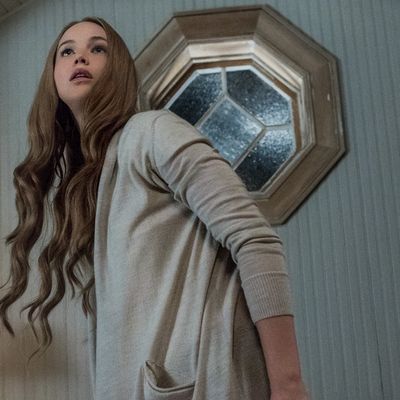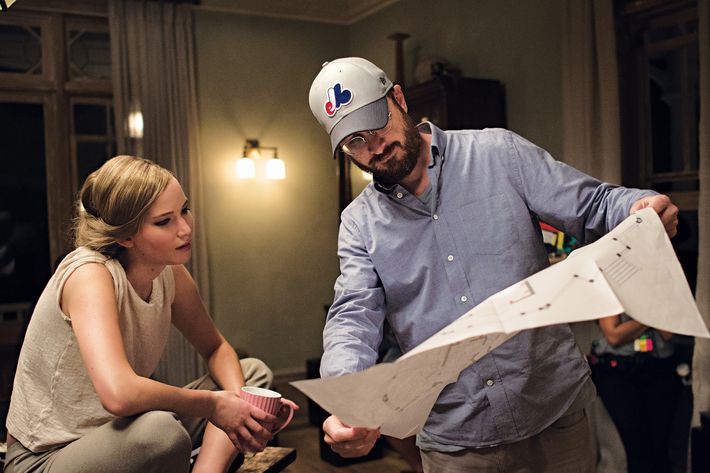
“Most people, after they see the film, they don’t even wanna look at me,” says Darren Aronofsky with a basso profundo chuckle. Clad in New Balances, a Montreal Expos hat, and a black T-shirt bearing the logo of electro-punk label DFA Records, the 48-year-old auteur is introducing his latest outing, the secrecy-shrouded Mother! (exclamation point required), to a microaudience of four — of which I am a part. We had to turn in nondisclosure agreements before being permitted to see the film, and a viewing of it suggests the reason why: Aronofsky doesn’t want you to know how, exactly, he’s going to push your buttons. But he’s going to push your buttons.
Aronofsky’s filmography is rich with moments of oft-surreal discomfort: It’s hard to shake off Winona Ryder stabbing herself in the face in Black Swan, or Russell Crowe nearly murdering a newborn in Noah, or Jennifer Connelly’s climactic scene in Requiem for a Dream, which I can’t even describe delicately here. But Mother! might be the most alarming entry in Aronofsky’s two-decade career. The film envisions a few months (or is it a few days?) in the countryside home of an idyllic couple, played by Jennifer Lawrence and Javier Bardem. Unexpected visitors (Ed Harris and Michelle Pfeiffer) arrive; horrifying entropy sets in.
Beyond that, Aronofsky would prefer to stay secretive about details. “It’s a cruise missile shooting into a wall, this film,” he muses a few days after the screening, seated in a dimly lit equipment room at a Manhattan sound-editing studio. “I want audiences to be prepared for that and prepped that it’s a very intense ride.”
I ask him how he’s going to get people excited to see a movie they know little about — so far, the marketing campaign has ranged from coy to downright opaque. The best you might intuit from the trailers and poster campaign is that it’s about a couple. Who live in a house. And something is going terribly wrong. The first teaser for Mother! was literally a black screen with disparate lines from the film spoken over it. There are “two things,” Aronofsky says, that should draw in an audience. One has to do with vague tonal suggestions from the sparse marketing materials: “Knowing that there’s some terrifying secret at the core of this thing, that the film’s going to go there, and you should only come if you’re ready to get on that roller coaster.” And the other is who’s behind the camera. “I want them to be clear that it’s the guy who made Requiem for a Dream and Black Swan and the threshold is as high, if not higher, than that. It’s definitely different than anything else out there right now. For anyone who has an appetite for that, we’ll try do to our best to serve up a delicious meal.”
For now, perhaps the best clue is the title: an emotionally loaded word further accentuated by its punctuation. “I think it reflects the spirit of the film,” he says. “The film kind of has an exclamation point; at the end of it, there’s a big exclamation point. So I think the title was just a bit better that way.” And, hey, it could’ve been a lot more extreme. “When I first wrote the title, it was M-O-T-H-E-R, by itself, then I did a polish and the title was Motherrr!!!—exclamation point, exclamation point, exclamation point,” he recalls with a laugh. “And Javier and Jen said to me, ‘That’s not the new title, is it?’ I was like, ‘Yeah, maybe!’ ”

Speaking of his star (and current girlfriend) Jennifer Lawrence: Without her, one can imagine this movie never happening. The narrative of Mother!, especially its conclusion, is an astounding anomaly in the risk-averse, tentpole-hugging Hollywood of 2017, even for a filmmaker as accomplished as Aronofsky. Add in the intense secrecy, and you can imagine Paramount being wary of the challenge of selling what is essentially a black box. And yet, Aronofsky says that it “wasn’t such a hard thing to convince people to do. I imagine that probably has to do with the fact that we attached Jen Lawrence to it as a first move.”
It also didn’t hurt that the project was relatively cheap and self-contained. Indeed, you could be forgiven for thinking it was made by an entirely different director from the one who constructed 2014’s Noah, with its apocalyptic scope, enormous budget, expansive set pieces, bizarre CGI animals, and boulder-carapaced angels. That Biblical epic seemed to signal a move for the director toward a broader scale — and though its reception was mixed, he says now, “at the end of the day, it was a profitable film and it was the film I wanted to make. So I’m happy with the results.” The breadth and scope of that film and this one couldn’t be more different. But, he says, after he was done with Noah, he wanted to go in a radical new direction. Except that radical direction wasn’t Mother! — not at first. “I was working on a kid’s movie, actually,” he says. “It’s based on my youth and my friends that I grew up with in South Brooklyn. But I was having some problems with it. I couldn’t quite break it. And I had this other idea floating around my head.”
Usually, Aronofsky writes down such stray ideas and returns to them later, but he couldn’t leave this new one — the one that would become Mother! — alone. “I sent it off to a friend to read, to get some notes,” he remembers. “I had a week alone while he was digesting it, and I kind of had this breakthrough figuring out how to structure it. And so I sat for about five days and I pumped it out.” That immediacy was new for him. “I’ve been very, very jealous of songwriters who in a day or in a week can write a song that represents an emotion,” he says. “As a filmmaker, it’s like two, three years at a minimum to get an emotion out. So I was really curious if there was a way to try to capture one type of emotion and put it into something and see if it would work. All those ideas, the intensity of all those ideas, just sort of flooded out of me.”
After that, Aronofsky moved the project into an unusual rehearsal process. “It was three months with Jen and Javier,” he recalls. “We got a warehouse in Brooklyn and taped out the set and for three months rehearsed it and then actually shot the entire movie on video with our operator and our DP. No lighting, though; it was just to get movement. Even though there were no walls and no staircases, we were able to get a sense of movement and camera movement, and learn from that.”
During those rehearsals, he was particularly focused on Lawrence, who provides Mother!’s incendiary core. “I think there were a lot of things that the script asked that I have never seen her do, so I was trying to figure out how we were going to get there,” he says. “And during the rehearsals, she was very, very relaxed. She was present, but never really pushed herself. It wasn’t appropriate for me to push that, even though I wasn’t sure how she was going to do it. And I really didn’t get to know the character until we started shooting, and she showed up.”
Perhaps too much so, at times. “I think she hyperventilated and also kind of threw a rib out,” he recalls. “During the big climax of the movie, I mean, she started …” He trails off, then gets an emphatic look on his face. “She really went there. The producers were freaking out. We had to sort of calm it down and then go for it again. And the thing is, there’s so much ability there that somehow she can summon it again and again.”
And she has to: The film is almost entirely composed of her or her immediate surroundings. “The film is basically either over her shoulder, on her face, or her POV,” Aronofsky says. “That’s the only shots. There are a few wide shots when she’s alone. But beyond that, the camera is basically in three places.” The result is an unsettlingly intimate finished product that puts the viewer inside her skin for two increasingly white-knuckled hours.
Aronofsky is hesitant to call the film an allegory, but he does say, “There’s more than meets the eye.” Whether or not there’s a specific statement being made, Mother! rises to the occasion of the present moment, emanating a sense of deep dread and rolling panic over the course of its run time. It is, in its way, a nano-dystopia; a world gone horrifically wrong inside just one house.
Therein lies the spoiler-free essence of Mother! — something is terribly, terribly out of joint these days, and it’s wholly unclear what there is to be done about it. Aronofsky doesn’t have the answers, but he wants to shout the questions at the top of his lungs. “There are these huge forces that are happening that you can look at and go, That’s wrong, and yet, no matter how much I scream about it, there’s nothing I can do, and it keeps happening,” he says. He pauses, shrugs, then comes to a conclusion about what he’s willing to say: “I just wanted the movie to howl at the moon.”
*This article appears in the August 21, 2017, issue of New York Magazine.


